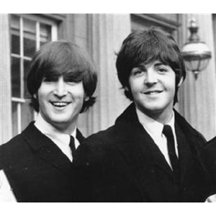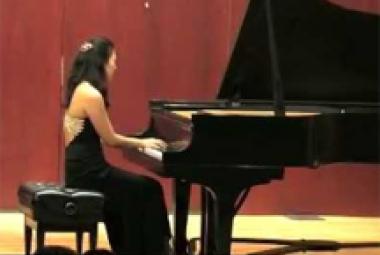Lennon–McCartney was the rock music songwriting partnership between English musicians John Lennon and Paul McCartney of the Beatles. It is one of the best known and most successful musical collaborations in history. Between 1962 and 1969, the partnership published approximately 180 jointly credited songs, of which the vast majority were recorded by the Beatles, forming the bulk of their catalogue. Sometimes, especially early on, they would collaborate extensively when writing songs, working “nose to nose and eyeball to eyeball”. Later, it became more common for one of the two credited authors to write all or most of a song with limited input from the other. Lennon–McCartney compositions have been the subject of numerous cover versions; according to Guinness World Records, “Yesterday” has been recorded by more artists than any other song. (More from Wikipedia)
As successful as Jagger/Richards have been – and over a much longer period of time – the songwriting partnership of Lennon/McCartney, that is John Lennon and Paul McCartney, might be even more so. From Wikipedia: “It is one of the best known and most successful musical collaborations in history. Between 1962 and 1969, the partnership published approximately 180 jointly credited songs, of which the vast majority were recorded by the Beatles, forming the bulk of their catalogue.”
Unlike many if not most songwriting teams, from the beginning John Lennon and Paul McCartney were adept at writing music as well as lyrics. Again, Wikipedia states: “Sometimes, especially early on, they would collaborate extensively when writing songs, working ‘nose to nose and eyeball to eyeball’. Later, it became more common for one of the two credited authors to write all or most of a song with limited input from the other.”
* * *
As I discussed last month, the Lennon/McCartney songwriters started much earlier than Jagger/Richards. John Lennon and Paul McCartney met in 1957 as teenagers and began writing songs together; they agreed almost immediately to share joint writing credits even for songs written entirely by one of them.
Two of their earliest songs are “One After 909” and “Hello Little Girl”, both written primarily by John Lennon; Wikipedia says that they date from 1957. “One After 909” was included on the Beatles’ very last album, Let it Be and was also performed during the famous rooftop concert that is included in the film, Let it Be.
“One After 909” definitely sounds like a song from that era. As quoted in Wikipedia, Paul McCartney has fond memories of this song: “It’s not a great song but it’s a great favorite of mine because it has great memories for me of John and I trying to write a bluesy freight-train song. There were a lot of those songs at the time, like ‘Midnight Special’, ‘Freight Train’, ‘Rock Island Line’, so this was the ‘One After 909’; she didn’t get the 909, she got the one after it.”
One of the highlights of Anthology 1 for me are some 1963 recordings of “One After 909”, when the Beatles tried unsuccessfully to put the song together for an early release. Three takes are presented, each of which breaks down after a short time. The compilers realized though that an entire performance of the song could be pieced together from these takes, and it is also given on the CD.
* * *
“Hello Little Girl” was included on the Decca Records audition tape; there is also a home demo recording of the song that features Stuart Sutcliffe on bass guitar, which is currently available only on bootleg albums. A version of “Hello Little Girl” by the Beatles is included on Anthology 1.
Like “I Wanna be Your Man”, which was first recorded by the Rolling Stones, “Hello Little Girl” was one of the songs that they gave to others to record. A little known Liverpool band (at least in this country) called the Fourmost first recorded “Hello Little Girl” in 1963 and made it to #9 on the British charts; Gerry and the Pacemakers also recorded the song in this time period.
I don’t know anything about the Fourmost except that I think they were the band that I saw in an early booklet or paper about the Beatles who were holding their guitars as though they were violins. I haven’t been able to find that photo on the Internet though. “Hello Little Girl” by the Fourmost opens Side 2 of an album called The Songs Lennon and McCartney Gave Away.
* * *
There are probably a lot of people who think of “Yesterday” as being the quintessential Beatles song. It is certainly their most successful – from Wikipedia: “It remains popular today with more than 2,200 cover versions and is one of the most covered songs in the history of recorded music. ‘Yesterday’ was voted the best song of the 20th century in a 1999 BBC Radio 2 poll of music experts and listeners and was also voted the No. 1 pop song of all time by MTV and Rolling Stone magazine the following year. In 1997, the song was inducted into the Grammy Hall of Fame. Broadcast Music Incorporated (BMI) asserts that it was performed over seven million times in the 20th century alone.”
However, this is not at all the way that “Yesterday” was viewed at the time. Although released as a Beatles song, “Yesterday” could be more properly viewed as a Paul McCartney solo work: Not only was Paul the sole songwriter, but he is also the only bandmember who performed on the song – he is accompanied by a string quartet.
* * *
I discussed last month that the opening riff from “(I Can’t Get No) Satisfaction” came to Keith Richards in a dream. “Yesterday” has a similar origin; Paul McCartney had the entire melody in his head after a dream (probably sometime in 1964), and he rushed to the piano to play the tune before it faded from memory. This worried him considerably, as he wondered whether his “dream” was actually someone else’s song; but after checking with several people, Paul was convinced that it was an original work. There were no lyrics initially; the working title of the song was “Scrambled Eggs”, with these opening lines: “Scrambled eggs / Oh, my baby how I love your legs”.
Paul McCartney worked on the song incessantly for months; John Lennon is quoted in Wikipedia about “Yesterday”: “The song was around for months and months before we finally completed it. Every time we got together to write songs for a recording session, this one would come up. We almost had it finished. Paul wrote nearly all of it, but we just couldn’t find the right title. We called it ‘Scrambled Eggs’ and it became a joke between us. We made up our minds that only a one-word title would suit, we just couldn’t find the right one. Then one morning Paul woke up, and the song and the title were both there, completed. I was sorry in a way, we’d had so many laughs about it.”
George Harrison had something to say about “Yesterday” as well: “Blimey, he’s always talking about that song. You’d think he was Beethoven or somebody!”. Producer George Martin also talked about the song at a later date: “‘[Yesterday]’ wasn’t really a Beatles record and I discussed this with Brian Epstein: ‘You know this is Paul’s song . . . shall we call it Paul McCartney?’ He said ‘No, whatever we do we are not splitting up the Beatles.’”
* * *
Surprisingly, “Yesterday” was not initially released as a single in England; from Wikipedia: “Since ‘Yesterday’ was unlike the Beatles’ previous work and did not fit in with their image, and was essentially a solo recording, the Beatles refused to permit the release of a single in the United Kingdom.”
Where rocking horse people eat marshmallow pies
Everyone smiles as you drift past the flowers
That grow so incredibly high
Newspaper taxis appear on the shore
Waiting to take you away
Climb in the back with your head in the clouds
And you’re gone
But it was on The Beatles (“the White Album”) where George Harrison really shone both as a performer and as a songwriter. By contrast, much of the Lennon/McCartney material were story songs about animals – Harrison also wrote one of these, “Piggies” – and throwaways like “Why Don’t We Do it in the Road”.
(June 2015)















